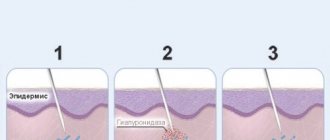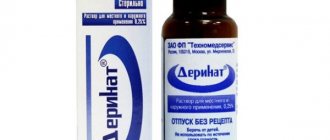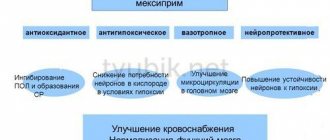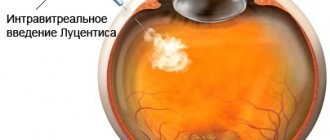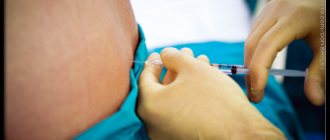Detailed description of the study
Currently, the treatment of infectious diseases is carried out in a pathogenetic (aimed at breaking the chain of inflammatory changes) and etiological (impact on the pathogen itself) method.
Since the number of people suffering from immunodeficiency conditions is growing, and long-term use of drugs aimed at eliminating the infectious agent leads to the formation of resistance to it, drugs are used aimed at strengthening the human body’s defenses.
Immunomodulators are agents that affect human immunity, acting not on the pathogen, but on the cells of the body’s defense system. One of the well-known drugs in this group is cycloferon (meglumine acridone acetate).
It has antiviral and immunomodulatory activity.
Its clinical effectiveness has been identified in the treatment of:
- Respiratory viral diseases, including influenza;
- Throat and nose infections;
- Herpetic infection,
Cycloferon is a Russian drug that is an interferon activator with the following properties:
- Antiviral;
- Anti-inflammatory;
- Immunomodulatory;
- Antitumor.
The drug increases the body's resistance to bacterial and viral infections.
Interferons are protein molecules related to cytokines, secreted by body cells during the invasion of viruses and other infectious agents. There are several types of interferons: alpha, beta and gamma.
Interferon alpha, or cellular, is synthesized by leukocytes and responds to the appearance of infectious agents (virus, bacteria), and interferon gamma - immune - is formed with the help of T-lymphocytes, providing an immunomodulatory and antitumor effect.
The role of interferons is to regulate intercellular interactions and cell growth. They have antiviral, immunomodulatory and antitumor activity.
To assess the activity of the immune system's response to cycloferon, it is important to study the release of the following interferons:
- Interferon gamma;
- Induced IFN-gamma;
- Spontaneous IFN-gamma;
- Alpha interferon;
- Serum interferon;
- Spontaneous IFN-alpha;
- Induced IFN-alpha.
This will allow you to evaluate the success of treatment with this drug.
CYCLOFERON in practical gynecology
In Ukraine, there is an increase in the number of gynecological diseases, in the pathogenesis of which disorders of the immune status are of paramount importance (Gutnev A.L., 2002). These are diseases of infectious origin (chlamydia, mycoplasmosis, candidiasis, genital herpes, cytomegalovirus infection, etc.), as well as pathology caused by dyshormonal heterotopic tissue proliferation (genital endometriosis).
The most important factor in the body's nonspecific defense against foreign tissue is the interferon-cytokine system, which is characterized by antiviral activity, immunocorrective and anticarcinogenic effects. To restore the function of this part of the immune system in gynecology, inducers of endogenous interferon synthesis are widely used. One of the well-known drugs in this group is CYCLOFERON
(NTFF "Polisan", St. Petersburg), which stimulates the production of a-, b- and g-interferon, which helps protect the body from infection by viruses, bacteria, protozoa, as well as inhibiting the growth of malignant cells. Antiviral properties are more characteristic of a- and b-interferon, the increase in the level of which determines the wide spectrum of antiviral action of CYCLOFERON. The use of the drug successfully prevents the development of relapses of viral infection. The immunoregulatory and antiproliferative properties of the drug are largely mediated through g-interferon. When the production of g-interferon is activated, CYCLOFERON normalizes the parameters of the T-cell immunity: the level of subpopulations CD3+ (T-lymphocytes), CD4+ (T-helpers), and CD16+ (natural killer cells), the number of which decreases in chronic and recurrent viral infections ; corrects the level of immunoglobulins M and E (IgM and IgE).
CYCLOFERON is available in various dosage forms: solution for injection 12.5% in ampoules of 2 ml No. 5 (registered in Ukraine in 1998), CYCLOFERON 5% LINIMENT in bottles of 5 ml (registered in Ukraine in 2001).
Urogenital chlamydia
, often accompanied by infertility, miscarriage, cervical diseases, chronic inflammatory diseases of the genital organs, as a rule, occurs against the background of suppressed T-cell immunity and impaired production of IgM and IgE, which complicates the treatment of patients. CYCLOFERON is used as an immunostimulant in addition to antibacterial therapy, taking into account the duration of the infectious process. Apply from 5 (for the treatment of patients with acute infections) to 10–20 injections of CYCLOFERON (for chronic infections) according to the scheme: 2 ml IM on the 1st, 2nd, 4th, 6th, 8th, 11th, 14th, 17th, 20th and 23rd days. When using CYCLOFERON, the effectiveness of therapy increases and the healing process accelerates.
In the scheme of complex treatment of patients with genital herpes
It is also advisable to include CYCLOFERON. In addition to the indirect effect on the virus through the immune system, CYCLOFERON has a direct effect, disrupting the process of viral replication, several times increasing the percentage of defective viral particles. The drug is used according to the scheme described above, and after 2-3 weeks the course of 5 injections is repeated. At the same time, CYCLOFERON 5% LINIMENT is used topically: the drug is administered intravaginally 1–2 times a day, 5 ml daily for 10–15 days. Recovery was noted in 88% of cases, clinical improvement - in 10% of cases; after recovery, stable remission occurred (Fedotov V.P. et al., 1999). To prevent relapses, CYCLOFERON therapy is combined with the administration of a herpetic vaccine. Before using the vaccine, 5 injections of CYCLOFERON are prescribed, after 1 day - a course of vaccination (5 injections of 0.1–0.2 ml every 72 hours). After 10 days the cycle is repeated.
It is believed that the increase in the number of patients and the low effectiveness of treatment of patients with urogenital candidiasis
are caused, in particular, by violations of the humoral and cellular immunity. The use of CYCLOFERON (according to the basic scheme - 8-10 injections) is justified if the duration of the process is more than 2 years, as well as in the presence of changes in the immunogram (Fedotov V.P. et al., 1999).
Prolonged course of gardnerella vaginitis
usually detected against the background of impaired immune status. The complex treatment of patients with a disease duration of more than 6 months includes 8–10 injections of CYCLOFERON to enhance the synthesis of endogenous interferon, which increases the effectiveness of specific therapy. For urogenital candidiasis and bacterial vaginosis, it is advisable to use CYCLOFERON 5% LINIMENT in the form of intravaginal instillations of 5–10 ml daily for 10–15 days, which significantly reduces the severity of symptoms of the disease (Isakov V.A., Aspel Yu.A., 1999) .
In the treatment of patients with external genital endometriosis
Along with hormonal, surgical, and enzyme therapy, the immunomodulator CYCLOFERON is used. To enhance the antiproliferative effect of the therapy, 2 courses of 5 injections of CYCLOFERON are prescribed at 2-week intervals, starting from the 1st day of the menstrual cycle (Ershov F.I. et al., 1999).
Good compatibility of CYCLOFERON with drugs traditionally used in the treatment of patients with the above diseases, as well as good tolerability, was noted. The drug is non-toxic, does not have an allergenic or carcinogenic effect, and local irritant effects are extremely rare. CYCLOFERON is contraindicated during pregnancy; systemic administration of the drug is contraindicated in severe liver dysfunction.
Detailed information, a list of references and texts of articles about CYCLOFERON can be found on the website of Medical Academy Pharmacies LLC www.ama.dp.ua
For questions regarding the purchase of the drug, please contact: 49044, Dnepropetrovsk, pl. Oktyabrskaya, 4, LLC “Pharmacies of the Medical Academy”; tel./fax
What else is prescribed with this study?
Humoral immunity (immunoglobulins IgA, IgM, IgG, IgE, circulating immunocomplexes, complement components C3, C4)
17.51. Venous blood 8 days
RUR 2,800 Add to cart
Immune status (screening) (Phagocytic activity of leukocytes, cellular immunity, total immunoglobulin IgE, immunoglobulins IgA, IgM, IgG)
27.960. Venous blood 3 days
6,010 RUR Add to cart
Immune status expanded
17.61. Venous blood 14 days
RUR 19,430 Add to cart
Cellular immunity (T-lymphocytes, T-helpers, T-cytotoxic cells, Immunoregulatory index, B-lymphocytes, NK-T cells, NK cells, Leukocyte formula)
17.50. Venous blood 3 days
RUR 4,270 Add to cart
CYCLOFERON® (Cycloferon®)
In adults
Cycloferon is used intramuscularly or intravenously once a day according to the basic regimen: every other day.
The duration of treatment depends on the disease.
1. For herpes and cytomegalovirus infection
the drug is administered according to the basic scheme - 10 injections of 0.25 g. The total dose is 2.5 g. Treatment is most effective at the beginning of an exacerbation of the disease.
2. For neuroinfections
the drug is administered according to the basic regimen. The course of treatment is 12 injections of 0.25-0.5 g in combination with etiotropic therapy. The total dose is 3-6 g. Repeated courses are carried out as needed.
3. For chlamydial infection
the drug is administered according to the basic regimen. The course of treatment is 10 injections of 0.25 g. The total dose is 2.5 g. A second course of treatment is carried out after 10-14 days. It is advisable to combine Cycloferon with antibiotics.
4. For acute viral hepatitis A, B, C,
D and mixed forms,
the drug is administered according to the basic regimen - 10 injections of 0.5 g each. The total dose is 5.0 g. In case of prolonged infection, the course is repeated after 10-14 days.
For chronic viral hepatitis B, C,
D and mixed forms,
the drug is administered according to the basic regimen - 10 injections of 0.5 g, then according to the maintenance regimen - three times a week for 3 months as part of complex therapy. Recommended in combination with interferons and chemotherapy. Repeat the course after 10-14 days.
5. For HIV infection (stages 2A - 2B)
the drug is administered according to the basic regimen - 10 injections of 0.5 g, then according to the maintenance regimen - once every three days for 2.5 months. Repeat the course after 10 days.
6. For immunodeficiency conditions
course of treatment - 10 intramuscular injections according to the basic regimen in a single dose of 0.25 g. The total dose is 2.5 g. A repeated course is carried out after 6-12 months.
7. For rheumatoid arthritis, systemic lupus erythematosus -
4 courses of 5 injections of 0.25 g each according to the basic regimen with a break of 10-14 days. A repeated course is carried out on the recommendation of a doctor.
8. For deforming osteoarthritis
— 2 courses of 5 injections of 0.25 g according to the basic regimen with a break of 10-14 days. A repeated course is carried out on the recommendation of a doctor.
In children over 4 years old
In pediatric practice, Cycloferon is used intramuscularly or intravenously once a day according to the basic regimen: every other day.
The daily therapeutic dose is
6-10 mg/kg body weight.
1. For acute viral hepatitis A, B, C,
D and mixed forms,
the drug is administered according to the basic regimen - 15 injections. If the infection is prolonged, the course is repeated after 10-14 days.
2. For chronic viral hepatitis B, C,
D
, the drug is administered according to a basic regimen of 10 injections, then according to a maintenance regimen - three times a week for 3 months as part of complex therapy. Recommended in combination with interferons and chemotherapy.
3. For HIV infection (stages 2A - 2B) -
a course of 10 injections according to the basic regimen, then according to the maintenance regimen - once every three days for 3 months. A repeat course is carried out after 10 days.
4. For herpetic infection -
course of 10 injections according to the basic scheme. If the replicative activity of the virus remains, the course of treatment is continued according to a maintenance regimen with administration of the drug once every three days for four weeks.
CYCLOFERON - a means of preserving reproductive health
S. B. Rybalkin, Candidate of Medical Sciences Regional Center for the Treatment and Prevention of Dermatological and Venereal Diseases, Penza M. G. Romantsov, Doctor of Medical Sciences Yu. V. Aspel, Infectious Diseases Physician of the Polisan Scientific and Technical Foundation, St. Petersburg
Since the beginning of the 90s, there has been an increase in sexually transmitted diseases on the territory of the Russian Federation.
The structure of the incidence of sexually transmitted infections is presented in the figure.
The age structure of those sick with ureaplasmosis, chlamydia and herpes raises some concern, since among the infected people there is a group of teenagers aged 15-19 years.
Therapy for sexually transmitted diseases remains open until recently. Antibacterial drugs and their combinations are widely used; treatment does not always lead to the desired effect, since the pathogen is not eliminated, and dysbacteriosis and immunodeficiency states often develop.
Among the drugs with anti-inflammatory and immunocorrective effects is the domestic low-molecular-weight inducer of endogenous interferon - cycloferon. In recent years, cycloferon has begun to be used for the treatment of various chronic slow viral and bacterial infections.
In this regard, the possibility of using cycloferon topically is of great interest. For this purpose, cycloferon liniment 5% was used.
The drug was administered to 89 patients whose age ranged from 18 to 35 years. The drug was prescribed randomly as patients were admitted. Cycloferon liniment was administered endourethrally in a volume of 5 ml every 24 hours, for a course of treatment from 7 to 11 instillations.
The control group consisted of 85 people who were instilled with saline solution according to a similar scheme against the background of antibacterial therapy.
When studying the tolerability of the drug according to the clinical analysis of the cellular elements of peripheral blood, no significant changes indicating phenomena of intolerance were noted. No changes in the mucous membranes indicating symptoms of irritation or allergization were detected; in isolated cases, administration of the drug to damaged mucous membranes (for gonorrheal urethritis) caused a short-term moderate burning sensation and pain.
Positive dynamics of clinical indicators were noted in patients receiving cycloferon, compared with those receiving standard (antibacterial) therapy. Clinical and instrumental examination showed a significant decrease and/or disappearance of inflammation in the urethra, normalization of erosive lesions of the mucous membranes. Patients stopped complaining of itching and burning.
In the group of patients with chlamydia, improvement was documented by a complex of clinical and laboratory methods in 86.2% of treated patients; in 13.8% of cases, after the end of therapy, elimination of the pathogen did not occur and a repeat course of treatment was required. In the chlamydia + ureaplasmosis group, improvement occurred at the end of treatment in 79.4% of patients. In the third group of patients (chlamydia + trichomoniasis), at the end of treatment, laboratory tests did not identify the causative agent of chlamydia, and the treatment of trichomoniasis required the inclusion of specific therapy. In the fourth group of patients (with ureaplasmosis), the pathogen was not determined in all treated patients, but in 15.6% of patients, during bacterioscopic examination of smears, moderate leukocytosis remained (up to 15-18 in the field of view), they were additionally prescribed Unidox. In patients with gonorrheal urethritis, instillations of liniment caused moderate pain (burning); after four instillations of liniment, gonococci were not detected in smears during bacterioscopic examination, although slight leukocytosis was documented in the smears, which normalized during treatment with Unidox.
In patients with gonorrheal urethritis due to trichomoniasis, the effectiveness of cycloferon was absent even with combined treatment with antibiotics; To achieve a clinical and laboratory effect, it was necessary to include specific agents - trichomonacid drugs.
Thus, summarizing the results of treatment of patients with urogenital infections, it is necessary to note the effectiveness of the use of liniment 5% cycloferon, documented by a complex of clinical and laboratory examination of 74.4-86.2% of treated patients, while a second course of therapy was required in 14-25% of patients.
The effect of antibiotic therapy was noted in all observed groups in 59-63% of patients.
Table 1. Dynamics of laboratory parameters in observed patients
| Laboratory test | Percentage of detection of positive results in the dynamics of observation | ||
| Initial examination | During therapy | At the end of therapy | |
| Bacterioscopic examination for gonorrheal infection | 100,0 | ||
| Bacterioscopic examination for trichomoniasis | 100,0 | 56,0 | 16,0 |
| Diagnosis of ureaplasmosis using direct immunofluorescence | 100,0 | 46,0 | 11,0 |
| Bacterioscopic examination of a smear: | |||
| leukocytes in the field of view: 30 | and 40.7 | 23,7 | — |
| above 10-20 | 37,8 | 12,9 | 6,5 |
| up to 5 | 21,5 | 18,0 | 8,4 |
| PCR method | 100,0 | But | 21,0 |
Structure of incidence (%) of infections with sexual transmission, 1996-1998.
| Syphilis | 26,1 |
| Trichomoniasis | 25,9 |
| Chlamydia | 15,4 |
| Ureaplasmosis | 14,6 |
| Gonorrhea | 11,6 |
| Gardenerellosis | 5,8 |
| Herpes | 0,6 |
Table 2. Indicators of clinical effectiveness of cycloferon liniment, %
| Indicators | Observable groups* | |
| First | Second | |
| Duration of illness (days) | 18,5±0,9** | 31,9±1,7** |
| Muco- and mucopurulent discharge | 13,7±0,5** | 18,8±2,1** |
| Inflammation of the urethra | 11,8±0,6** | 18,9±2,2** |
| Erosion of the mucous membrane | 21,7±1,1 | 34,8±1,9** |
| * The first group - patients receiving cycloferon; the second - patients who received basic (antibacterial) therapy ** P≤0.5-0.01 in comparable indicators | ||
Table 3. The effectiveness of therapy with the inclusion of 5% cycloferon in the course of treatment of liniment
| No. | STI form | Therapy effectiveness, % | |
| Improvement | No effect | ||
| 1 | Chlamydia | 86,2 | 11,8 |
| 2 | Chlamydia + ureaplasmosis | 79,4 | 20,6 |
| 3 | Chlamydia + trichomoniasis | -/78,0 | -/22,0 |
| 4 | Ureaplasmosis | 84,4 | 15,6 |
| 5 | Gonorrheal urethritis | 78,9 | 21,1 |
| 6 | Gonorrheal urethritis + trichomoniasis | 78,2 | 21,8 |
| 7 | Trichomoniasis | 74,4 | 25,6 |
CYCLOFERON solution for injection. 12.5% amp. 2 ml No. 5
Directions for use and doses
Adults: Cycloferon is used intramuscularly and/or intravenously once a day according to the basic regimen on days 1, 2, 4, 6, 8, 11, 14, 17, 20, 23, 26, 29, depending on the nature of the disease. For acute viral hepatitis in a single dose of 0.25-0.5 g (1-2 ampoules) according to the given scheme of 10 injections (course 2.5-5 g). In the chronic form of viral hepatitis B, continue treatment according to the maintenance regimen: 1 injection (0.25 g) once every 5 days for up to 3 months. For hepatitis C and mixed forms, it is recommended to use the drug in a single dose of 0.5 g once a week for 6 months. For herpes and cytomegalovirus infection, according to the given scheme, 10 injections of 0.25 g (course 2.5 g). Treatment is most effective at the beginning of an exacerbation. For frequently recurrent forms of herpetic infection, combination with other antiherpetic drugs is recommended. For neuroinfections, the basic course is 12 injections (course 3-6 g). Repeat courses as needed. For bacterial and fungal infections, the basic course is 5 injections (1.25 g) with mandatory combination with etiotropic therapy. Repeat the course after 5-7 days as needed. For chlamydial infection, 10 injections according to the basic regimen (course 2.5-5 g). Be sure to repeat the course after 3-4 weeks. Mandatory combination with antibiotics. It is most effective to add an antibiotic after the second injection of Cycloferon. It is necessary to change the antibiotic from the eleventh day of treatment with Cycloferon. For mixed infection, intravenous administration of the drug is recommended. For HIV infection, a basic course of monotherapy with Cycloferon is recommended, consisting of 10 injections of 0.5 g each. The first three injections of 0.5 g are administered intravenously, then intramuscular maintenance administration of the drug is prescribed once every seven days for up to a year. For immunodeficiency conditions, 10-12 injections of 0.25 g, then a maintenance course of 1 injection of 0.25 g every 5-7 days for 4-6 months. For rheumatic and systemic connective tissue diseases, 4 courses of 5 injections (1.25 g) are prescribed with a break of 10-14 days. Repeat the course as needed. For degenerative-dystrophic diseases of the joints, 2 courses of 5 injections (1.25 g) are prescribed with a break of 10-14 days. Repeat the course of treatment as needed. Children: Cycloferon is used intramuscularly and/or intravenously once a day. The daily therapeutic dose is 6-10 mg/kg body weight.
